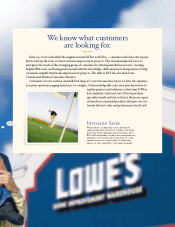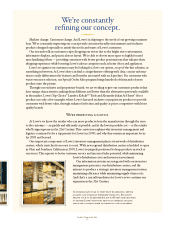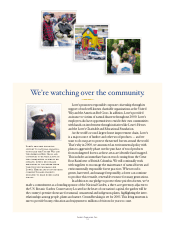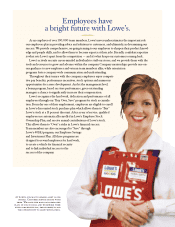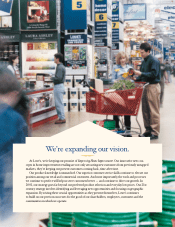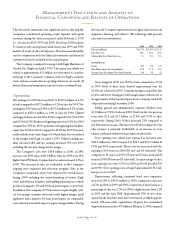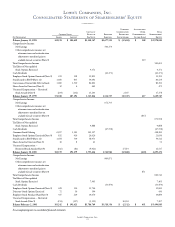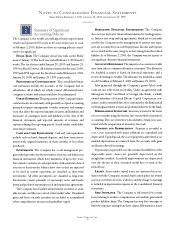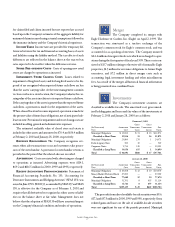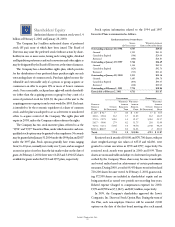Lowe's 2000 Annual Report Download - page 23
Download and view the complete annual report
Please find page 23 of the 2000 Lowe's annual report below. You can navigate through the pages in the report by either clicking on the pages listed below, or by using the keyword search tool below to find specific information within the annual report.
Lowe’s Companies, Inc.
21
The Company has a $300 million revolving credit facility with
a syndicate of eleven banks expiring in November 2001. The facil-
ity is used to support the Company’s commercial paper program
and for short-term borrowings. Commercial paper outstanding
under this credit facility was $149.8million as of February 2,
2001. The Company has available lines of credit aggregating $218
million for the purpose of issuing documentary letters of credit
and standby letters of credit. At February 2, 2001, outstanding
letters of credit aggregated $133.2million. The Company also has
$100 million available, on an unsecured basis, for the purpose of
short-term borrowings on a bid basis from various banks. At
February 2, 2001, there were no borrowings outstanding under
this line of credit. In addition, the Company has a $100 million
revolving credit and security agreement from a financial institu-
tion with $100 million outstanding at February 2, 2001.
The Company’s 2001 capital budget is currently at $2.7bil-
lion, inclusive of approximately $286 million of operating or cap-
ital leases. Approximately 89% of this planned commitment is for
store expansion and new distribution centers. Expansion plans for
2001 consist of approximately 115 to 120 stores (including the
relocation of 12 older, smaller format stores). This planned expan-
sion is expected to increase sales floor square footage by approxi-
mately 18% to 20%. Approximately 6% of the 2001 projects will
be leased and 94% will be owned. At February 2, 2001, the
Company operated five regional distribution centers. During
2000, the Company began construction on two additional
regional distribution centers. The first is located in Perris,
California and is expected to be operational in the first quarter of
2001. The second is located in Findlay, Ohio and is expected to be
operational in late 2001. During 2001, it is expected that the
Company will begin construction on a 900,000-square-foot
regional distribution center located in Cheyenne, Wyoming. The
Company believes that funds from operations, funds from debt
issuances, leases and existing short-term credit agreements will be
adequate to finance the 2001 expansion plan and other operating
requirements.
Market Risk
The Company’s major market risk exposure is the potential loss
arising from the impact of changing interest rates on long-term
debt. The Company’s policy is to manage interest rate risks by
maintaining a combination of fixed and variable rate financial
instruments. The following table summarizes the Company’s
market risks associated with long-term debt. The table presents
principal cash outflows and related interest rates by year of matu-
rity, excluding unamortized original issue discount. Fair values
included below were determined using quoted market rates or
interest rates that are currently available to the Company on debt
with similar terms and remaining maturities.
Long-Term Debt Maturities by Fiscal Year
Average Average
Fixed Interest Variable Interest
(Dollars in Millions) Rate Rate Rate Rate
2001 $ 26.1 7.58% $ 0.1 4.60%
2002 43.2 7.63 0.1 4.60
2003 11.9 7.58 0.1 4.60
2004 59.1 7.95 0.1 4.60
2005 612.7 7.32 0.1 4.60
Thereafter
1,534.0 7.30% 2.1 4.27%
Total
$ 2,287.0 $ 2.6
Fair Value
$ 2,269.1 $ 2.6
The Company’s market risk has not changed materially since
last year with the exception of new debt issued during 2000.
New Accounting Pronouncements
Statement of Financial Accounting Standards No. 133,
“Accounting for Derivative Instruments and Hedging Activities”
(SFAS 133), was issued in June 1998. SFAS 133, as amended by
SFAS 137 and SFAS 138, is effective for the Company as of
February 3, 2001 and requires that all derivatives be recognized as
either assets or liabilities in the balance sheet at fair value.
Management does not believe that the adoption of SFAS 133 will
have a material impact on the Company’s financial condition and
results of operations.


